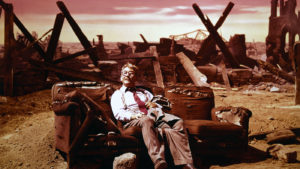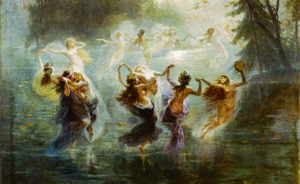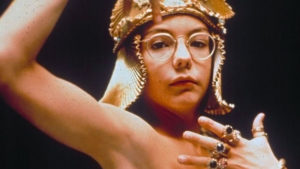Those visiting Romania for the first time will often be told that its association with vampires is really an unfair imposition, having mostly to do with Bram Stoker’s invention of a Transylvanian setting for his 1897 novel, Dracula. His tale, you will hear, is a typically Victorian confession of England’s own deepest fears — of pestilence; of pathologia sexualis, hopelessly interwoven with what would soon be called the “death-drive”; of uncouth swarthy continentals.
In the shadow of Bran Castle, once home to Vlad the Impaler, you might enjoy the irony of hearing this revisionist history lesson while surrounded by a whole gallery of vampire kitsch — kiosks with plastic fangs for sale; a Dracula face-in-a-hole board as diminutive and unthreatening as his descendants Count Chocula, of breakfast-cereal fame, or Sesame Street’s own Count von Count.
Listening to such lectures in the past, I would often find myself unable to suppress that exclamation, so completely taboo in our era of stay-in-your-lane deference: “Well, actually…” Because the truth is that tales of vampires existed in the Balkans long before Bram Stoker. Between the 15th and the 19th centuries, the figure of the vampire made the gradual transition from the proto-ethnography of the Balkans to the imaginations of Gothic littérateurs.
Most succinctly, we may say that the figure of the vampire emerges out of the confluence of three elements. The first is the real historical record of the actions of a certain Vlad Țepeș (1428/31—1476/77). The violent transgressions for which he became notorious were extreme — notably, impalement on rounded and greased spikes, carefully avoiding direct puncture of inner organs so as to prolong the victim’s misery. Woodcuts depicting his deeds were soon published in German books, and as these circulated the legends surrounding him grew beyond all human proportion.
The second element is the arrival of Germanophone Habsburg administrators in newly subordinated regions of Southeastern Europe, who had been influenced in their practices by the emerging culture of the Republic of Letters, which encouraged literate travellers in little-known places to note down and to report back to the metropole all rare or mysterious incidents. The third element, finally, are the ancient folk-cultural practices and beliefs that these humble clerks observed and documented.
Of particular importance in the revisionist lesson for foreigners in Transylvania is the task of clearing Dracula from any association with vampirism. “Dracula”, they explain, is simply the title, but not the name, of Vlad Țepeș, also known as Vlad III or Vlad the Impaler. He inherited it from his father, Vlad II, a member of the Order of the Dragon. In Romanian, dracul derives from the Latin draco, and simply means “the dragon”.
It is not in fact in the castles, but in the villages of Romania that we typically hear rumours of the strigoi, which are in turn close cousins of the vrykolakas of Greece and the upior of the Slavic countries. These are, in all their regional variants, ghosts of the deceased, poltergeists who return to trouble the living. A common belief holds that one may prevent their apparition by sealing the coffin of the dead shut with extra nails, and by driving a stake through the chest of the corpse. Should one encounter a strigoi, some texts and traditions counsel the use of apotropaics such as garlic or holy water to ward them off. These folkloric characters thus share some, but not all, of the traits associated with the Stokerian vampire. There is as yet no strong association with bats, for example, or with hematophagy.
It is at least true, then, that Stoker’s rendition bumps the vampire up several social classes from where it had always resided in “authentic” folk culture, from the peasantry to the aristocracy. And it is the elevation of traditional village practices to a form of aristocratic decadence that enables Stoker to give his fiction a historical grounding, and to identify his own protagonist’s vampirism as part of an inheritance from none other than Vlad the Impaler:
“Who was it but one of my own race who as Voivode [a military leader] crossed the Danube and beat the Turk on his own ground? This was a Dracula indeed! Woe was it that his own unworthy brother, when he had fallen, sold his people to the Turk and brought the shame of slavery on them! Was it not this Dracula, indeed, who inspired that other of his race who in a later age again and again brought his forces over the great river into Turkey-land?”
In portraying Vlad as a hero in the war against the Turks, the Irish novelist is channelling a historiographical tendency more commonly seen in Russia and the Balkans than in Western Europe. In the Orthodox lands, while his cruelty is acknowledged, Vlad is mostly seen as a valiant defender against the Ottoman menace, and therefore as a bulwark of Christendom. In the German-speaking world, by contrast, his significance as a military leader pales in comparison with his inhuman and gratuitous cruelty. Beginning as early as the 1460s, broadsides circulated describing the delight Vlad took in roasting babies alive and forcing their mothers to eat them, in hearing the low moans of his impaled victims as musical accompaniment to his meals.
Horrific tales of Vlad the Impaler were not the only source of vampire mythology. Non-fictional writing on strange incidents and curiosities stretches back to antiquity, but it is in the wake of the scientific revolution that a more systematic approach develops to the collection of eyewitness reports, largely inspired by the learned journal of the Royal Society of London, The Philosophical Transactions, founded in 1666.
The first extant treatise on vampirism is De masticatione mortuorum in tumulis [On the Chewing of the Dead in their Tombs], published in 1725, by the German Lutheran pastor and historian Michaël Ranfft. In his work, Ranfft helped to make vampires known throughout the German-speaking world by republishing a report from a minor administrator in the Serbian provinces of the Kingdom of Hungary, who described some peculiar events in the village of Kisolova following the death of a certain Petar Blagojević, of whom “it was stated that, within eight days [of his death], nine people, both old and young, died after enduring an illness of 24 hours”. It is reported that: “As they still lay alive on their death beds… the above-mentioned Plogojovitz [sic], who had died ten weeks prior, came to them in their sleep, lay down on top of them, and croaked that they must now give up their souls.”
The author of the report cited by Ranfft uses the word “vampire” in one of its earliest printed occurrences. He reports that “since among similar people (as are called Vampyri) there must be visible various signs, as that their bodies are undecayed, with skin, hair, beard, and nails growing”, the villagers resolved to open up the grave of Petar Blagojević and to see what they might discover there. Here is what they found:
“That, first of all, the body and its grave were not in the least touched by the usual smell of the dead. The body, other than the nose, which had somewhat fallen off, was very fresh; the hair and the beard, and also the nails, of which the older ones had fallen away, had grown on him; the old skin, which was somewhat white, had peeled away, and a new fresh skin had come forth underneath; the face, hands and feet, and the whole body were so composed that they could not have been more perfect during the course of his life. Not without surprise I glimpsed fresh blood in his mouth, which, according to the common expression, he had sucked from those he had killed.”
At issue in part was a puzzlement about some unexpected contingencies in the way bodies decompose. While they often rot quickly, depending on the circumstances of the air, the temperature, and the presence of microorganisms, bodies can also come to appear, under the right conditions, even more healthy than they had been just prior to death. Sometimes a corpse is found with blood streaming from the mouth, a natural consequence of the internal breakdown of the organs, which nonetheless can easily be mistaken for a vestige of recent feasting. They frequently become bloated, and in an era in which corpulence was still strongly associated with health, this temporary condition could easily appear as an improvement only to be explained on the assumption that the corpse had been ingesting food — food, that is, or blood.
The difficulty of determining the precise boundary between life and death is a subject that reappears throughout the 18th century — not just in reference to vampires, but in numerous medical treatises. The most interesting example of such work is undoubtedly the Danish-French physician Jacques-Bénigne Winslow’s 1742 Dissertation on the Uncertainty of the Signs of Death, and the Misuse of Burials, and Rushed Embalmings. Winslow cites several authorities to establish the view that “putrefaction is the only infallible sign of death”.
Winslow also peppers his treatise with macabre reports, many of which read like Gothic fiction. Thus we learn of a lady of Auxbourg, who, “falling into a Syncope, in Consequence of a Suffocation of the Matrix, was buried in a deep Vault, without being covered with Earth… Some Years after, however, one of the same Family happening to die, the Vault was open’d, and the Body of the young Lady found on the Stairs at its Entry, without any Fingers on the Right Hand.” Soon enough, documentary sources such as this were sublimated into fictional stories about the undead, Edgar Allen Poe’s The Premature Burial (1844) being a prime example.
The early modern explosion of interest in Balkan “superstition” is, as we have begun to see, in no small measure an effect of the encounter between the Catholic and Orthodox worlds, and in particular of the expansion of Habsburg rule into regions of the Balkans that had previously belonged to the Ottoman Empire. This encounter triggered a long — and indeed still ongoing — habit of representing Southeastern Europe as a land of benighted and backwards belief.
In his contribution to the 1776 Dictionnaire philosophique, none other than Voltaire, who never misses an opportunity to scoff at people who happen not to be French, takes up the example of vampires not only as a measure of the distance between Enlightened Europe and those other parts, but also between the rationality of the ancient Greeks and the irrationality of their degenerated modern descendants. “Who would believe that the fashion of vampires came from Greece? This is not the Greece of Alexander, of Aristotle, of Plato, of Epicurus, of Demosthenes, but rather Christian Greece, which is, unfortunately, schismatic.”
Voltaire is a defiant atheist, but his polemical anti-clericalism brings him close to some of the themes of anti-Papism familiar from Protestant lands. For many Protestant authors, the difference between Catholicism and worship of the forces of darkness is but another case of the narcissism of minor differences. Voltaire, writing in this same spirit, speaks mockingly of a young sceptic who had dared to question the truth of a number of reported miracles involving the Virgin Mary, and who finally was won over to all manner of Catholic articles of faith as a result of exposure to folk-beliefs about vampires. In his satirical account, it was best for the weak-minded to shelter themselves from stories of vampires, if only because these can all too easily serve as a gateway drug to the Roman religion.
Among Catholic authors, by contrast, we generally see not mockery of folk-beliefs about vampires, but rather a subtle, almost mischievous, effort to occupy the ambiguous space between affirmation and scepticism. Indeed, a convention emerges in vampirological works over the course of the 18th century, whereby the author is generally presented as an intrepid and dedicated, but perhaps somewhat shadowy character. This doubt is in turn offset by an assurance that the author is a man of the cloth, an abbey or a clergyman who has immersed himself in the study of dark forces in order to better combat them for the sake of humanity’s salvation. Which side, a reader constantly wonders, is the author really on?
Whether writing as a science-oriented debunker, or as a pious fighter against the forces of darkness, or indeed as some mixture of these two, vampirologists always seem to be infected by their subject. Sceptics will see them as frivolous for wasting their intellectual energy on an old folk myth, and the pious will see them as rather too interested, for suspicious reasons, in the very thing they are supposed to be fighting against. It is hard to be taken seriously as a vampirologist.
And yet it still seems to me that vampires are due a certain measure of rehabilitation. The vampire, I think, is at least as “good to think with” as the “philosophical zombie” that has historically been preferred by analytic philosophers. Zombies give us all of the conceptual problems about mind and consciousness, but none of the feeling, and are thus perfect water-carriers for whatever it is the analytics are trying to do. To “think with vampires” is by contrast to think about feeling, mood, and the dimensions of human existence these disclose.
In its essence, a vampire is a being that knows it is dead, and feels infinite sadness about its plight. This is a paradoxical situation to be in, since death is supposed to be the cessation of all consciousness. But it is also fairly close to what we imagine when we try, per impossibile, to imagine death. We do so, mostly, by feeling our way into it, until we can bear no more and recoil. We do so by allowing what that feeling discloses to us to count for something. And also in our dreams, notably, we encounter dead people with surprising regularity. They walk and talk, and give us tidings, yet there’s something off about them, by which we understand that they are dead. An impossible condition — yet there they are.
A longer version of this essay first appeared at Justin E. H. Smith’s Hinternet.
Disclaimer
Some of the posts we share are controversial and we do not necessarily agree with them in the whole extend. Sometimes we agree with the content or part of it but we do not agree with the narration or language. Nevertheless we find them somehow interesting, valuable and/or informative or we share them, because we strongly believe in freedom of speech, free press and journalism. We strongly encourage you to have a critical approach to all the content, do your own research and analysis to build your own opinion.
We would be glad to have your feedback.
Source: UnHerd Read the original article here: https://unherd.com/





